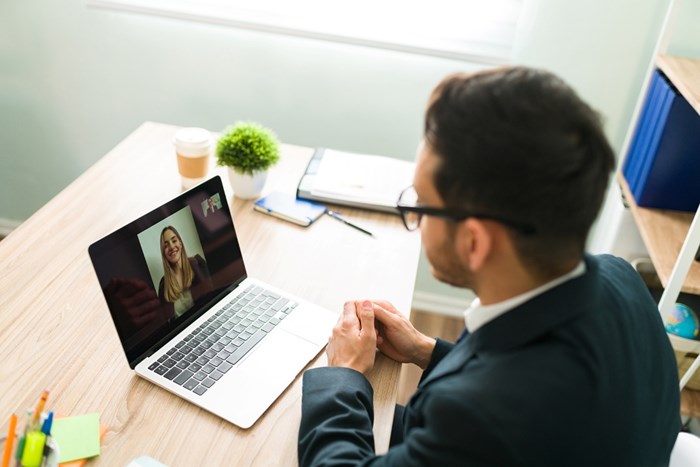The digital job interview: Tips for success

Landing your first job as a plastic surgeon is an exciting moment that's been years in the making, but the first job interview after residency or Fellowship can be uncomfortable and challenging to navigate. With the ongoing pandemic, another stressful piece of the equation is the virtual interview process – but we're all adapting and there are some strategies to make the situation work in your favor. The Harvard Business Review earlier this year published tips on nailing a digital job interview, and while there's often little about the interview process that's guaranteed, some tips can help stack the odds in your favor.
Visual impressions
Your virtual environment can make a huge impact on your first impression, and while this can be daunting (especially in a small living space), it provides an advantage in being able to control your surroundings. Find a neutral, empty wall – possibly with a few tasteful decorations to convey that you are organized and attentive to detail. A cluttered background will appear disorganized and could distract your interviewers to the point where they might be focused more on your background than your words. If you can, avoid sitting directly against the wall; leave some space to give depth to your appearance. The back of your chair should not be higher than your shoulders, as this can also be a distracting visual effect.
Face a window that provides natural light to make yourself more visible. A window behind you can create a silhouette effect that makes you hard to see. A ring light could be a good idea, but make sure it doesn't cast a glare. Don professional attire (in general, solid colors are less distracting for interviewers). Even if the interviewer cannot see your legs, it's still important to wear nice shoes and pants to feel fully prepared – and to avoid any awkward moments if you accidentally stand up.
Point of focus
Maintaining eye contact throughout an interview conveys respect and confidence. This is achieved virtually by looking at the camera lens – not the screen. One tip is to place a small photo of a loved one (pets count!) next to the lens to train your focus and remind you to smile.
Using a laptop or desktop computer is preferable due to the location of the camera lens. Even though most mobile phone cameras boast high-quality lenses, getting the appropriate angle and position can be challenging; if not executed correctly, bad angles and positions can diminish your virtual presence. Place your laptop on a small box or a stack of books so the camera lens is at eye level to make the interviewers feel engaged.
Try to consistently employ non-verbal cues, such as head nods, for positive affirmation. Exaggerate hand gestures more than usual to really convey emotion in a virtual setting. There will be fewer opportunities to infuse the conversation with your uniqueness and emotions, so these extra physical details can be helpful.
Removing distractions
It should go without saying, but your interviewers need to know that this conversation is your No. 1 priority. Turn off your pager. Silence your phone. Consider placing these devices out of sight so a pop-up notification or vibration doesn't steal your attention. Extend this train of thinking to your computer, as well. Disable notifications, close other windows and expand the teleconference window full-screen.
Be familiar with your mute and stop video buttons if a small break occurs in the conversation. Coordinate with anyone else in your household – well before your interview – so any adjustments that need to be made can happen seamlessly. Be aware of ambient noise (e.g., open windows that might amplify sounds such as nearby traffic or lawnmowers).
Preparation is key
Despite the ubiquity of video communication over the past 18 months, pauses and inadvertent speaking over the other person will still occur – and in some cases, this can be more awkward than were the conversation happening face-to-face. Try to negate any potential breaks in conversation. Many telecommunications platforms provide easy access to prepared notes or questions to ask the interviewers (often optimized as short phrases on index cards and printed with a large font, rather than lengthy paragraphs).
As we're all now well aware, video calls can be monotonous, so breaking up a conversation with engaging questions should be welcomed. As would be advised for an in-person interview, research your interviewers and potential future practice in order to ask targeted questions and stimulate good conversation.
Always confirm a reliable internet connection well beforehand and have a backup device available, in the event an irreparable software issue (or unexpected service interruption) arrives. Seek out friends and family to practice and give feedback on your virtual presence. Don't forget to verify the time zone that your interviewer is in when confirming the interview time.
Have fun
Remember, this moment is something to be celebrated. You made it through training and now you're ready to join a practice. Enjoy the process as well as the ability to connect with some of the amazing plastic surgeons in our specialty. Plastic surgery is a small community – even tighter within some subspecialties – so even if one particular job opportunity isn't for you, you'll likely interact with your interviewers again at some point. Good luck!
Dr. Myers is a clinical assistant professor of plastic surgery at the University of Michigan.